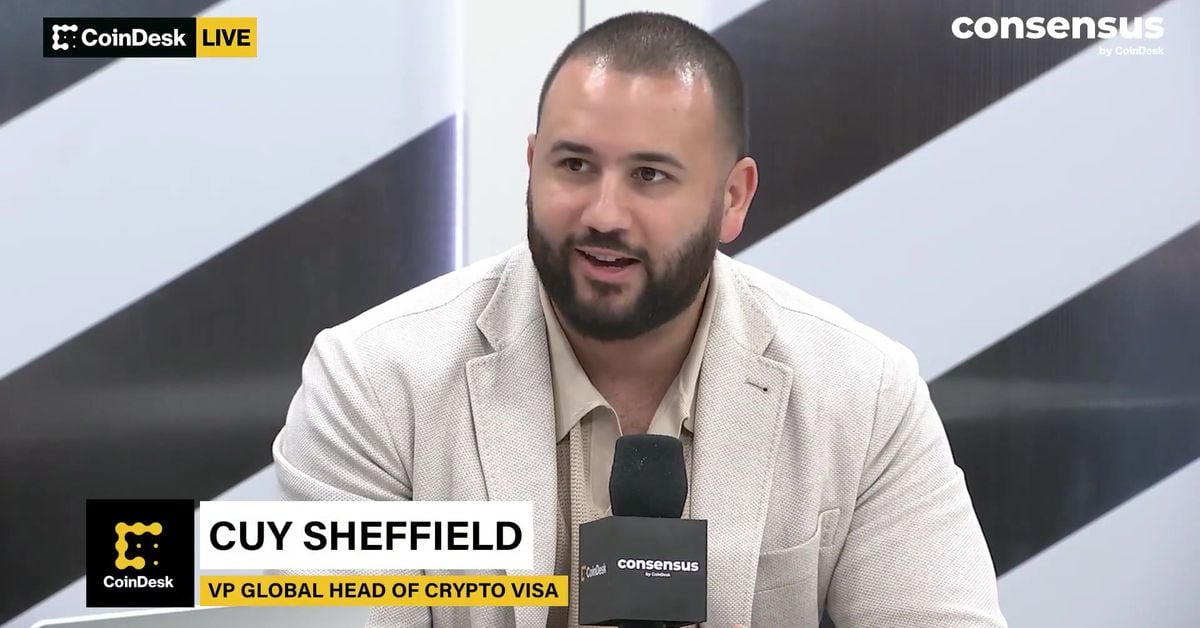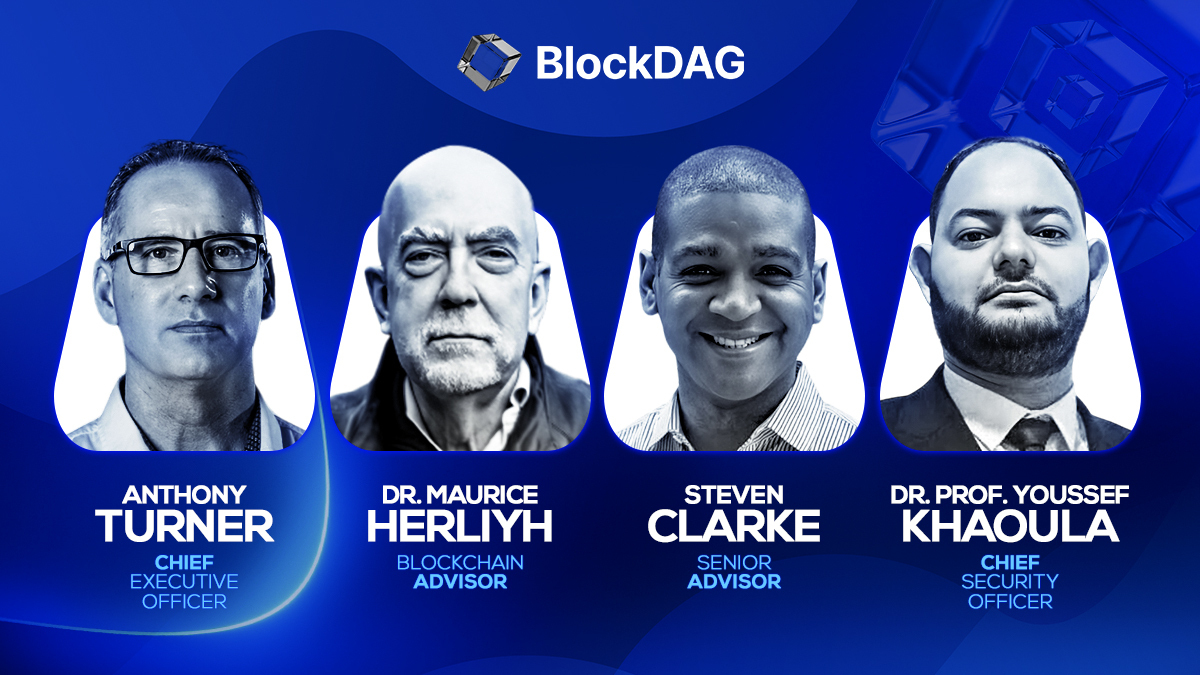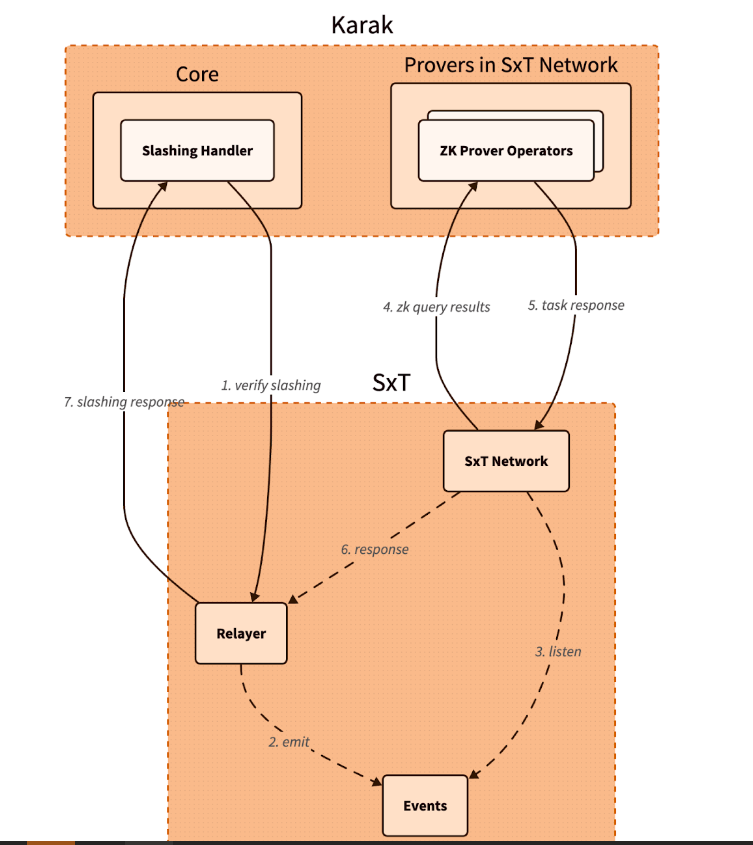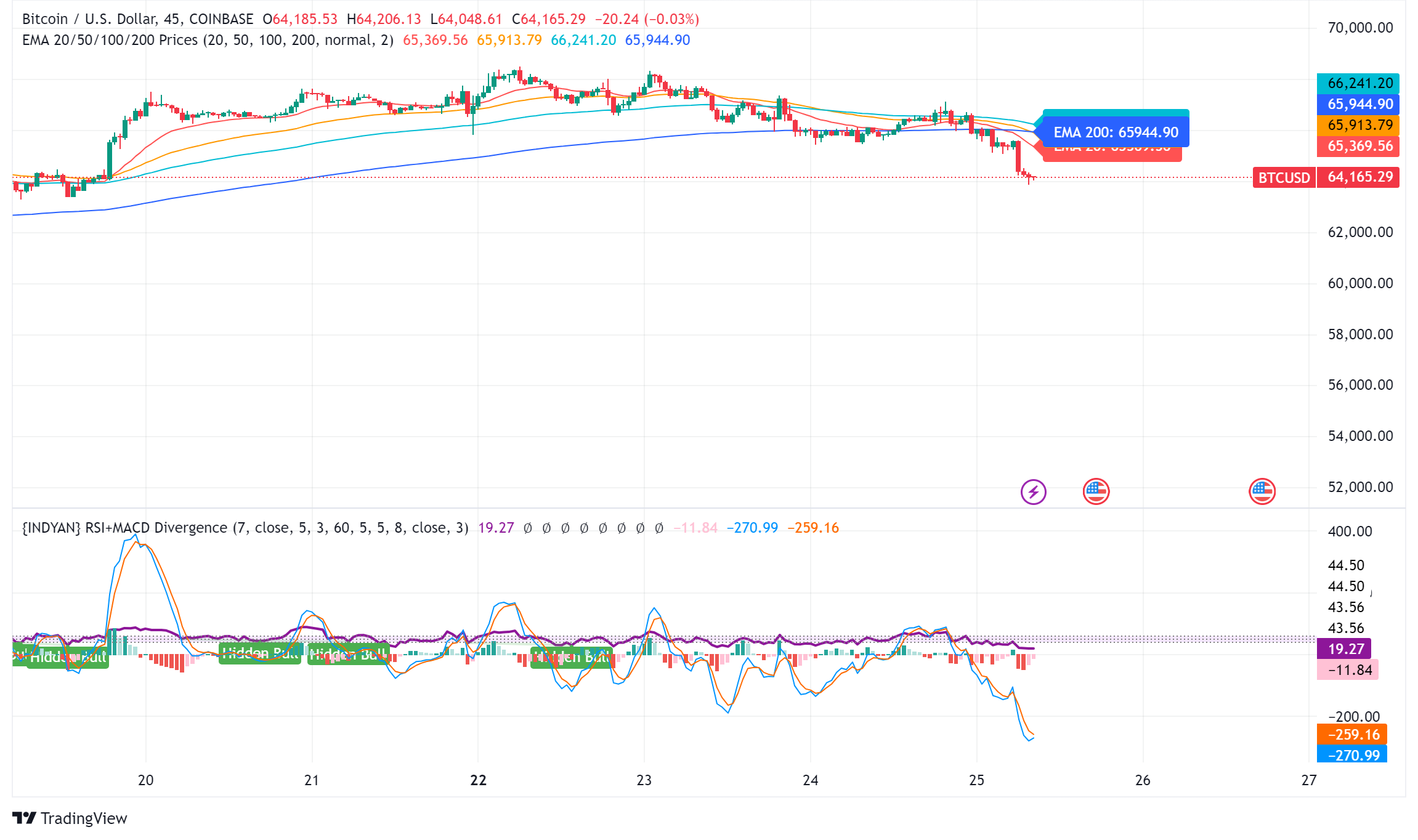Tech
Visa is the “bridge” between payments and Blockchain technologies: responsible for cryptocurrencies | video

We welcome Visa’s head of cryptocurrency, Kai Sheffield, to the show. Welcome, it’s great to be here. Thanks for having me. Thanks for sitting there while we did our little puppet show. Is fantastic. All right. So we’re at the 2024 consensus. Uh Tell us about what your experience has been so far. This is the second day. What were the vibes like for you? Is fantastic. I think there’s a lot of energy and momentum. We’re really excited to see what developers are building and, and really, how much, you know, Blockchain technology has started to mature and how the infrastructure has improved and you know, a lot of different payments use cases, you know, that you think that stablecoins, which you know, can help enable this. And so it’s been great to interact with a lot of customers, a lot of companies and partners in the payments ecosystem who are all researching and exploring how Blockchain technologies can be used to improve payment flows. Now Visa is one of the most important companies for payments of any kind in the world. And you’ve been there for a while as the head of crypto, I’m wondering from a couple of years ago, how have the conversations changed between then and now internally, like the ideas that you’re championing for the projects that you’re pushing, like Has the inside of a visa changed over time? So we’ve been making really steady progress, you know, consistently every week for five years now. And we actually built the crypto team in the depths of the bear market in late 2018, early 2019. And so our approach was really based on a long-term view. Uh Visa is said to be concerned with any technology that has the potential to improve payments. And so we wanted to take our time, you know, figure out how we could use these technologies to support, you know, our partners. Uh And, you know, we started experimenting with stable coins. We started doing a lot of research and a lot of training, you know, for our customers. And our goal is to continue making consistent and steady progress over the next decade. Uh And we’re really excited about the opportunities that particularly stable coins can offer five years for bulls and bears. It was a nice setup. We didn’t know that we were going to do this with our puppets, um internally. Has there ever been any pushback from anyone who challenged you during the bear market? For example, should we put time and effort into building this industry that seems to be quite unstable? I don’t think we’re, we’ve been really fortunate to be part of a company that has a culture that, you know, from the very beginning, from the early days of Visa and, you know, Dee Haw, you know, going back to the sixties, you know , recognize that value will be digitized. It’s going to move across a lot of different networks, and we want to be the single point of connection for customers, you know, to move value to a lot of different places in a lot of different payment flows. Uh And so we recognize that, you know, cryptocurrency prices are volatile. We don’t really care about the pricing, we care about the underlying technology and the ways in which it can be implemented within the payments ecosystem, but it takes time to do it and you have to do it in a client controlled, you know, secure way. Uh And so we’re really here for the long haul and we’ve continued to make steady progress, you know, despite current market cycles in a recent research paper on visas, I believe you and your colleagues have found that multi trillion dollar stability coin market, only a fraction of them are actually used by real people in terms of payment, I think 100 and 49 billion or some figure like that, which is a large number, but it is, it is not representative of the stable use of coins all in all. What do you think it will take to increase that number and increase the actual adoption of stablecoins as an appropriate means of payment. So, first of all, we think one of the unique aspects of stablecoins is the fact that you could see all the data, you know, on the chain. And so we’ve invested a lot of time and resources and how to understand the on-chain data and understand how stable coins are used. Uh And so we partner with AM Labs, we created a seen dashboard on chain analytics.com. And it was really this exercise of, you know, we use internally on chain data. Uh, you know, it answers some questions, it opens up a lot of other questions and we wanted to make it available as a free public tool and resource for our clients, for politicians, for the media. And you know, we started with these adapted transactions, you know, metric, you know, trying to filter out transactions that appear to be initiated, you know, by bots or as part of smart contracts. It’s not perfect. Uh So we’re not saying that’s it, that’s the end of it. But we think there’s so much opportunity that the industry can really use on-chain data to, you know, better understand how people are using stablecoins. And for us it’s not like stable coins are used by consumers to buy coffee. Its stable coins are used for things like large-value B-to-B payments. Uh cross border, you know, peer to peer. Uh And so I think we’re just at the point where we’re crossing the divide between consumers who are already in the crypto space, trading crypto on an exchange using stable coins, you know, paying other people in crypto for there’s an infrastructure that can enable for mainstream consumers, particularly outside the United States in emerging markets, to pay each other, to pay companies in many of these flows, on the rails of Blockchain, but there’s still a long way to go. Um, we’re excited to figure out how we can partner with existing companies in the payments ecosystem to start integrating stable coins in unique ways. And we think it should be both together. It is neither a traditional payment network nor a stablecoin. Will it be how they can interact with each other to improve payments? Tell us something more about it. What is Visa’s role in the future of stablecoins? Yes. So we see ourselves as a bridge between Blockchain technology stablecoins and the existing payments ecosystem. One of the things we’re doing is investing in how we can use stablecoins within some of our core products. You know, for example, when you tap to pay with a Visa card, it’s immediately authorized and you could walk out of the store. But there’s a lot of things that have to happen in order for the money to move from the issuer of that card, you know, to the merchant bank on the other side. And so we started experimenting with stablecoins like us cc that run on blockchains like solana to give our customers the ability to settle with us, you know, on a Blockchain. So we can receive stable coins, you know, into an account that we have in a circle, we can then convert them, you know, to pay in fiat to the choir merchant. And so I think we have such a broad and diverse network of traditional financial institutions, fintechs and crypto companies. We are trying to understand how the visa can be a bridge so that not all those companies adopt stable coins and blockchain at the same time, let’s meet them where they are. If they want to use stablecoins, great, we could support it. They operate in traditional fiat. We’ll handle conversions, you know, within it. So we’re excited to see how we can play that role, that bridging role. And this reminds me that before the contestants I cut my hair before the conference, like we all do. Uh, my barbershop only takes cash. I said, oh, it was just about the fees because often small businesses don’t like credit cards because of the fees. He said no, it’s actually not because of taxes. It’s because on Fridays, if I get paid by credit card, I can’t go to the bank to withdraw the money because the banks are closed. So I’m wondering how Visa is thinking about actually helping small businesses use and realize that stable coins could allow for instant settlement and could accept digital payments. Uh and you don’t have to worry about things like banks closing on weekends. Yes. So, there’s a lot of things that we’re doing across the company trying to accelerate, you know, how quickly we can get money, particularly for small businesses. You know, we have a product called Visa Direct that you could do, push payments and be able to have a small business, get money straight to their debit card over a weekend. And so we don’t think that it’s just stable coins. We believe stablecoins have potential and, on the back end of existing Visa products, could potentially move money faster. But we believe there are many ways the payments ecosystem will continue to evolve and drive revenue by getting small businesses where they need them faster. It seems that Visa is focused when it comes to cryptocurrencies on stable coins. I have to ask you in 2022. I was so excited when I heard that Visa had trademark applications for things like NFTS and Metaverse and, and wallets. Uh what’s up with those? Is there any focus on this? They have been put aside while you focus on stablecoin research dashboards and look at how a visa can work with stablecoins. So we continued to follow the NFT ecosystem and the broader creator economy. Um, we think it’s definitely evolved and changed. And I think, you know, when we started, you know, exploring, experimenting with NFTS, NFTS were really only on blockchains like Ethereum and they were quite expensive to run and, you know, there was an ecosystem of, you know, the fine art that people were, collected. Now, I think some of the changes that we’re starting to see are around a lot of NFTS use cases like things like loyalty. You know, you can now mint NFTS for fractions of cents. And so we’re seeing interesting experiments with things like digital receipts and loyalty programs where if you own an NFT, you can get a discount on several purchases. And so, you know, the culture that we have is really trying to learn by doing and, you know, working with customers around proof of concepts. We have a visa consulting and analytics business where issuers and merchants have come to us to say, how do we incorporate NFTS into a loyalty program? And so we’re absolutely still interacting with the ecosystem and experimenting. I think we’ve just seen a lot of the use cases for NFTS evolve a little bit from where they were a few years ago, but overall, we’re still really excited about the broader economy and the role that blockchains could play within it. Hi, thank you so much for joining us this morning. We hope you enjoy the rest of the conference. Thanks for having me. It was great. That was the head of Visa’s Crypto Kai Sheffield.
Tech
Harvard Alumni, Tech Moguls, and Best-Selling Authors Drive Nearly $600 Million in Pre-Order Sales

BlockDAG Network’s history is one of innovation, perseverance, and a vision to push the boundaries of blockchain technology. With Harvard alumni, tech moguls, and best-selling authors at the helm, BlockDAG is rewriting the rules of the cryptocurrency game.
CEO Antony Turner, inspired by the successes and shortcomings of Bitcoin and Ethereum, says, “BlockDAG leverages existing technology to push the boundaries of speed, security, and decentralization.” This powerhouse team has led a staggering 1,600% price increase in 20 pre-sale rounds, raising over $63.9 million. The secret? Unparalleled expertise and a bold vision for the future of blockchain.
Let’s dive into BlockDAG’s success story and find out what the future holds for this cryptocurrency.
The Origin: Why BlockDAG Was Created
In a recent interview, BlockDAG CEO Antony Turner perfectly summed up why the market needs BlockDAG’s ongoing revolution. He said:
“The creation of BlockDAG was inspired by Bitcoin and Ethereum, their successes and their shortcomings.
If you look at almost any new technology, it is very rare that the first movers remain at the forefront forever. Later incumbents have a huge advantage in entering a market where the need has been established and the technology is no longer cutting edge.
BlockDAG has done just that: our innovation is incorporating existing technology to provide a better solution, allowing us to push the boundaries of speed, security, and decentralization.”
The Present: How Far Has BlockDAG Come?
BlockDAG’s presale is setting new benchmarks in the cryptocurrency investment landscape. With a stunning 1600% price increase over 20 presale lots, it has already raised over $63.9 million in capital, having sold over 12.43 billion BDAG coins.
This impressive performance underscores the overwhelming confidence of investors in BlockDAG’s vision and leadership. The presale attracted over 20,000 individual investors, with the BlockDAG community growing exponentially by the hour.

These monumental milestones have been achieved thanks to the unparalleled skills, experience and expertise of BlockDAG’s management team:
Antony Turner – Chief Executive Officer
Antony Turner, CEO of BlockDAG, has over 20 years of experience in the Fintech, EdTech, Travel and Crypto industries. He has held senior roles at SPIRIT Blockchain Capital and co-founded Axona-Analytics and SwissOne. Antony excels in financial modeling, business management and scaling growth companies, with expertise in trading, software, IoT, blockchain and cryptocurrency.
Director of Communications
Youssef Khaoulaj, CSO of BlockDAG, is a Smart Contract Auditor, Metaverse Expert, and Red Team Hacker. He ensures system security and disaster preparedness, and advises senior management on security issues.

advisory Committee
Steven Clarke-Martin, a technologist and consultant, excels in enterprise technology, startups, and blockchain, with a focus on DAOs and smart contracts. Maurice Herlihy, a Harvard and MIT graduate, is an award-winning computer scientist at Brown University, with experience in distributed computing and consulting roles, most notably at Algorand.
The Future: Becoming the Cryptocurrency with the Highest Market Cap in the World
Given its impressive track record and a team of geniuses working tirelessly behind the scenes, BlockDAG is quickly approaching the $600 million pre-sale milestone. This crypto powerhouse will soon enter the top 30 cryptocurrencies by market cap.
Currently trading at $0.017 per coin, BlockDAG is expected to hit $1 million in the coming months, with the potential to hit $30 per coin by 2030. Early investors have already enjoyed a 1600% ROI by batch 21, fueling a huge amount of excitement around BlockDAG’s presale. The platform is seeing significant whale buying, and demand is so high that batch 21 is almost sold out. The upcoming batch is expected to drive prices even higher.

Invest in BlockDAG Pre-Sale Now:
Pre-sale: https://purchase.blockdag.network
Website: https://blockdag.network
Telegram: https://t.me/blockDAGnetwork
Discord: Italian: https://discord.gg/Q7BxghMVyu
No spam, no lies, just insights. You can unsubscribe at any time.
Tech
How Karak’s Latest Tech Integration Could Make Data Breaches Obsolete

- Space and Time uses zero-knowledge proofs to ensure secure and tamper-proof data processing for smart contracts and enterprises.
- The integration facilitates faster development and deployment of Distributed Secure Services (DSS) on the Karak platform.
Karak, a platform known for its strong security capabilities, is enhancing its Distributed Secure Services (DSS) by integrating Space and Time as a zero-knowledge (ZK) coprocessor. This move is intended to strengthen trustless operations across its network, especially in slashing and rewards mechanisms.
Space and Time is a verifiable processing layer that uses zero-knowledge proofs to ensure that computations on decentralized data warehouses are secure and untampered with. This system enables smart contracts, large language models (LLMs), and enterprises to process data without integrity concerns.
The integration with Karak will enable the platform to use Proof of SQL, a new ZK-proof approach developed by Space and Time, to confirm that SQL query results are accurate and have not been tampered with.
One of the key features of this integration is the enhancement of DSS on Karak. DSS are decentralized services that use re-staked assets to secure the various operations they provide, from simple utilities to complex marketplaces. The addition of Space and Time technology enables faster development and deployment of these services, especially by simplifying slashing logic, which is critical to maintaining security and trust in decentralized networks.

Additionally, Space and Time is developing its own DSS for blockchain data indexing. This service will allow community members to easily participate in the network by running indexing nodes. This is especially beneficial for applications that require high security and decentralization, such as decentralized data indexing.
The integration architecture follows a detailed and secure flow. When a Karak slashing contract needs to verify a SQL query, it calls the Space and Time relayer contract with the required SQL statement. This contract then emits an event with the query details, which is detected by operators in the Space and Time network.
These operators, responsible for indexing and monitoring DSS activities, validate the event and route the work to a verification operator who runs the query and generates the necessary ZK proof.
The result, along with a cryptographic commitment on the queried data, is sent to the relayer contract, which verifies and returns the data to the Karak cutter contract. This end-to-end process ensures that the data used in decision-making, such as determining penalties within the DSS, is accurate and reliable.
Karak’s mission is to provide universal security, but it also extends the capabilities of Space and Time to support multiple DSSs with their data indexing needs. As these technologies evolve, they are set to redefine the secure, decentralized computing landscape, making it more accessible and efficient for developers and enterprises alike. This integration represents a significant step towards a more secure and verifiable digital infrastructure in the blockchain space.
Website | X (Twitter) | Discord | Telegram
No spam, no lies, just insights. You can unsubscribe at any time.
Tech
Cryptocurrency Payments: Should CFOs Consider This Ferrari-Approved Trend?

Iconic Italian luxury carmaker Ferrari has announced the expansion of its cryptocurrency payment system to its European dealer network.
The move, which follows a successful launch in North America less than a year ago, raises a crucial question for CFOs across industries: Is it time to consider accepting cryptocurrency as a form of payment for your business?
Ferrari’s move isn’t an isolated one. It’s part of a broader trend of companies embracing digital assets. As of 2024, we’re seeing a growing number of companies, from tech giants to traditional retailers, accepting cryptocurrencies.
This change is determined by several factors:
- Growing mainstream adoption of cryptocurrencies
- Growing demand from tech-savvy and affluent consumers
- Potential for faster and cheaper international transactions
- Desire to project an innovative brand image
Ferrari’s approach is particularly noteworthy. They have partnered with BitPay, a leading cryptocurrency payment processor, to allow customers to purchase vehicles using Bitcoin, Ethereum, and USDC. This satisfies their tech-savvy and affluent customer base, many of whom have large digital asset holdings.
Navigating Opportunities and Challenges
Ferrari’s adoption of cryptocurrency payments illustrates several key opportunities for companies considering this move. First, it opens the door to new customer segments. By accepting cryptocurrency, Ferrari is targeting a younger, tech-savvy demographic—people who have embraced digital assets and see them as a legitimate form of value exchange. This strategy allows the company to connect with a new generation of affluent customers who may prefer to conduct high-value transactions in cryptocurrency.
Second, cryptocurrency adoption increases global reach. International payments, which can be complex and time-consuming with traditional methods, become significantly easier with cryptocurrency transactions. This can be especially beneficial for businesses that operate in multiple countries or deal with international customers, as it potentially reduces friction in cross-border transactions.
Third, accepting cryptocurrency positions a company as innovative and forward-thinking. In today’s fast-paced business environment, being seen as an early adopter of emerging technologies can significantly boost a brand’s image. Ferrari’s move sends a clear message that they are at the forefront of financial innovation, which can appeal to customers who value cutting-edge approaches.
Finally, there is the potential for cost savings. Traditional payment methods, especially for international transactions, often incur substantial fees. Cryptocurrency transactions, on the other hand, can offer lower transaction costs. For high-value purchases, such as luxury cars, these savings could be significant for both the business and the customer.
While the opportunities are enticing, accepting cryptocurrency payments also presents significant challenges that businesses must address. The most notable of these is volatility. Cryptocurrency values can fluctuate dramatically, sometimes within hours, posing potential risk to businesses that accept them as payment. Ferrari addressed this challenge by implementing a system that instantly converts cryptocurrency received into traditional fiat currencies, effectively mitigating the risk of value fluctuations.
Regulatory uncertainty is another major concern. The legal landscape surrounding cryptocurrencies is still evolving in many jurisdictions around the world. This lack of clear and consistent regulations can create compliance challenges for companies, especially those operating internationally. Companies must remain vigilant and adaptable as new laws and regulations emerge, which can be a resource-intensive process.
Implementation costs are also a significant obstacle. Integrating cryptocurrency payment systems often requires substantial investment in new technology infrastructure and extensive staff training. This can be especially challenging for small businesses or those with limited IT resources. The costs are not just financial; a significant investment of time is also required to ensure smooth implementation and operation.
Finally, security concerns loom large in the world of cryptocurrency transactions. While blockchain technology offers some security benefits, cryptocurrency transactions still require robust cybersecurity measures to protect against fraud, hacks, and other malicious activity. Businesses must invest in robust security protocols and stay up-to-date on the latest threats and protections, adding another layer of complexity and potential costs to accepting cryptocurrency payments.
Strategic Considerations for CFOs
If you’re thinking of following in Ferrari’s footsteps, here are the key factors to consider:
- Risk Assessment: Carefully evaluate potential risks to your business, including financial, regulatory, and reputational risks.
- Market Analysis: Evaluate whether your customer base is significantly interested in using cryptocurrencies for payments.
- Technology Infrastructure: Determine the costs and complexities of implementing a cryptographic payment system that integrates with existing financial processes.
- Regulatory Compliance: Ensure that cryptocurrency acceptance is in line with local regulations in all markets you operate in. Ferrari’s gradual rollout demonstrates the importance of this consideration.
- Financial Impact: Analyze how accepting cryptocurrency could impact your cash flow, accounting practices, and financial reporting.
- Partnership Evaluation: Consider partnering with established crypto payment processors to reduce risk and simplify implementation.
- Employee Training: Plan comprehensive training to ensure your team is equipped to handle cryptocurrency transactions and answer customer questions.
While Ferrari’s adoption of cryptocurrency payments is exciting, it’s important to consider this trend carefully.
A CFO’s decision to adopt cryptocurrency as a means of payment should be based on a thorough analysis of your company’s specific needs, risk tolerance, and strategic goals. Cryptocurrency payments may not be right for every business, but for some, they could provide a competitive advantage in an increasingly digital marketplace.
Remember that the landscape is rapidly evolving. Stay informed about regulatory changes, technological advancements, and changing consumer preferences. Whether you decide to accelerate your crypto engines now or wait in the pit, keeping this payment option on your radar is critical to navigating the future of business transactions.
Was this article helpful?
Yes No
Sign up to receive your daily business insights
Tech
Bitcoin Tumbles as Crypto Market Selloff Mirrors Tech Stocks’ Plunge

The world’s largest cryptocurrency, Bitcoin (BTC), suffered a significant price decline on Wednesday, falling below $65,000. The decline coincides with a broader market sell-off that has hit technology stocks hard.
Cryptocurrency Liquidations Hit Hard
CoinGlass data reveals a surge in long liquidations in the cryptocurrency market over the past 24 hours. These liquidations, totaling $220.7 million, represent forced selling of positions that had bet on price increases. Bitcoin itself accounted for $14.8 million in long liquidations.
Ethereum leads the decline
Ethereal (ETH), the second-largest cryptocurrency, has seen a steeper decline than Bitcoin, falling nearly 8% to trade around $3,177. This decline mirrors Bitcoin’s price action, suggesting a broader market correction.
Cryptocurrency market crash mirrors tech sector crash
The cryptocurrency market decline appears to be linked to the significant losses seen in the U.S. stock market on Wednesday. Stock market listing The index, heavily weighted toward technology stocks, posted its sharpest decline since October 2022, falling 3.65%.
Analysts cite multiple factors
Several factors may have contributed to the cryptocurrency market crash:
- Tech earnings are underwhelming: Earnings reports from tech giants like Alphabet are disappointing (Google(the parent company of), on Tuesday, triggered a sell-off in technology stocks with higher-than-expected capital expenditures that could have repercussions on the cryptocurrency market.
- Changing Political Landscape: The potential impact of the upcoming US elections and changes in Washington’s policy stance towards cryptocurrencies could influence investor sentiment.
- Ethereal ETF Hopes on the line: While bullish sentiment around a potential U.S. Ethereum ETF initially boosted the market, delays or rejections could dampen enthusiasm.
Analysts’ opinions differ
Despite the short-term losses, some analysts remain optimistic about Bitcoin’s long-term prospects. Singapore-based cryptocurrency trading firm QCP Capital believes Bitcoin could follow a similar trajectory to its post-ETF launch all-time high, with Ethereum potentially converging with its previous highs on sustained institutional interest.
Rich Dad Poor Dad Author’s Prediction
Robert Kiyosaki, author of the best-selling Rich Dad Poor Dad, predicts a potential surge in the price of Bitcoin if Donald Trump is re-elected as US president. He predicts a surge to $105,000 per coin by August 2025, fueled by a weaker dollar that is set to boost US exports.
BTC/USD Technical Outlook
Bitcoin price is currently trading below key support levels, including the $65,500 level and the 100 hourly moving average. A break below the $64,000 level could lead to further declines towards the $63,200 support zone. However, a recovery above the $65,500 level could trigger another increase in the coming sessions.
-

 Videos1 month ago
Videos1 month agoAbsolutely massive: the next higher Bitcoin leg will shatter all expectations – Tom Lee
-

 News12 months ago
News12 months agoVolta Finance Limited – Director/PDMR Shareholding
-

 News12 months ago
News12 months agoModiv Industrial to release Q2 2024 financial results on August 6
-

 News12 months ago
News12 months agoApple to report third-quarter earnings as Wall Street eyes China sales
-

 News12 months ago
News12 months agoNumber of Americans filing for unemployment benefits hits highest level in a year
-

 News1 year ago
News1 year agoInventiva reports 2024 First Quarter Financial Information¹ and provides a corporate update
-

 News1 year ago
News1 year agoLeeds hospitals trust says finances are “critical” amid £110m deficit
-

 Markets1 year ago
Markets1 year agoWhale Investments in Bitcoin Hit $100 Billion in 2024, Fueling Insane Investor Optimism ⋆ ZyCrypto
-

 DeFi1 year ago
DeFi1 year ago🏴☠️ Pump.Fun operated by Insider Exploit
-

 Videos1 year ago
Videos1 year ago$1,000,000 worth of BTC in 2025! Get ready for an UNPRECEDENTED PRICE EXPLOSION – Jack Mallers
-

 Videos1 year ago
Videos1 year agoABSOLUTELY HUGE: Bitcoin is poised for unabated exponential growth – Mark Yusko and Willy Woo
-

 Tech1 year ago
Tech1 year agoBlockDAG ⭐⭐⭐⭐⭐ Review: Is It the Next Big Thing in Cryptocurrency? 5 questions answered





